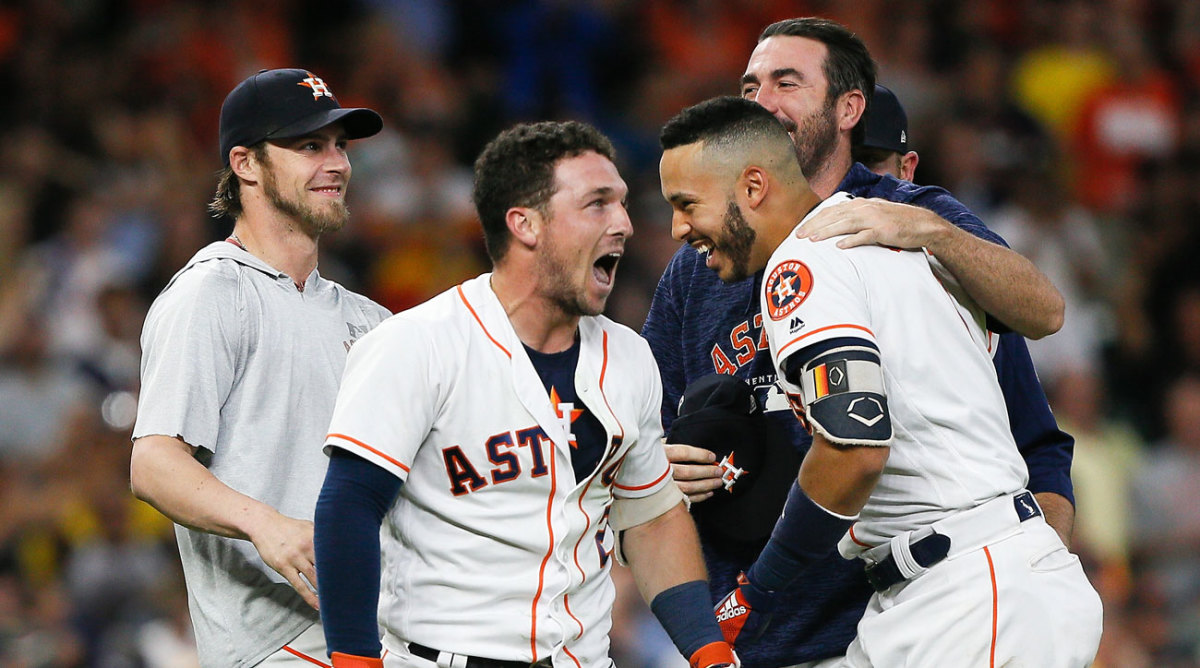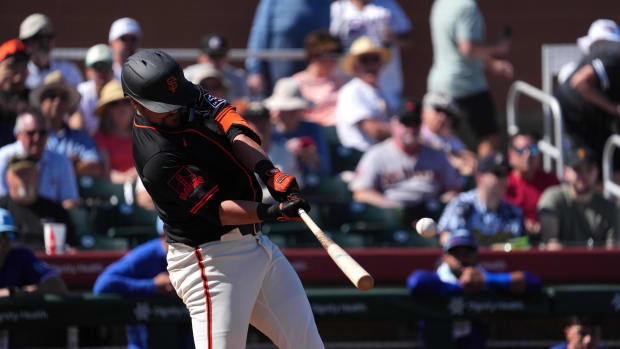The Houston Astros Are Only Getting Better

Thanks to the heroics of Alex Bregman, the Astros made franchise history on Monday night. Down 4–3 in the ninth to the Rays and with an 11-game winning streak on the line, Houston rallied, keyed by Bregman’s two-run–walk-off double off Sergio Romo. That 12th straight win tied the team record for most consecutive victories, first set in 1999 and matched in 2004; another one on Tuesday night against Tampa will leave the 2018 Astros alone at the top.
But beyond putting their names into the record books, the Astros’ win streak is as good a sign as any that they haven’t missed a beat in their world championship defense. At 49–25, Houston is on a 107-win pace that would blow away last year’s 101–61 finish. They’re percentage points behind both the Red Sox (49–24) and Yankees (47–22) in the standings, but it’s hard not to consider the Astros to be baseball’s best team yet again.
It helps that they’re top of the charts in so many different categories. The Astros have the game’s highest run differential (+158) and have scored the most runs (388, 17 ahead of Boston). Houston hitters lead the majors in OPS+ (120) and wRC+ (117), are top three in every slash stat and are second only to the Yankees in weighted on-base average (.336). And they’re masters of putting the ball in play, ranking fifth in contact percentage (78.8, just a point behind first-place Atlanta) and first in swinging-strike rate (9.3%).
None of that should be surprising, given that the Astros are coming off one of the greatest offensive seasons in major league history. Last year’s Houston squad was a juggernaut, leading the league in runs, all three slash stats, OPS, OPS+, weighted on-base average, and wRC+, and finishing second in home runs all while posting the lowest strikeout rate in baseball. But in just about every major offensive stat, this year’s Astros are lagging behind last season’s crew, thanks mostly to slight drops in performance from AL MVP Jose Altuve (just five homers so far after hitting 24 last season), Carlos Correa, and George Springer.
BACCELLIERI: The Astros (predictably) lead our Power Rankings
Other members of the Astros’ vaunted lineup have also stumbled, particularly in the outfield. Leftfielder Marwin Gonzalez has regressed after his excellent season as a super-utility guy in 2017. Veteran rightfielder Josh Reddick has battled injuries and ineffectiveness. And reserve Jake Marisnick has been awful at the dish, with 60 strikeouts in 132 plate appearances and an OPS+ of 46. Luckily for Houston, better years from Bregman (.266/.371/.464 with a 137 OPS+) and Evan Gattis (a team-high 14 home runs and a 128 OPS+ a year after he went deep just 12 times and was barely league average at the plate) have cushioned those blows and kept the Astros’ offense at the top.
The Astros boasting that kind of firepower was already unfair. Where it gets infuriating for the rest of the American League is that the pitching has caught up. Last year’s Houston rotation was a patchwork construction, assembling innings and starts from 11 different pitchers but never looking all that strong. Somehow, the innings leader for that 101-win squad was Mike Fiers, who posted a 5.22 ERA and 76 ERA+. Regular starters Charlie Morton, Dallas Keuchel, Brad Peacock, Lance McCullers and Collin McHugh all struggled with injuries, with not one cracking the 150-inning mark, and by season’s end, only Keuchel, Morton and Peacock were comfortably above league average in ERA+.
The 2018 rotation, though, can reasonably claim to be not just the best in baseball, but, to this point, arguably one of the best in the game’s history. That’s thanks largely to Justin Verlander, who helped stabilize the rotation late in the season after coming over from Detroit and was the ace of the team’s playoff run, and Gerrit Cole, added this winter in a trade with Pittsburgh. The former has been unhittable, with an AL-best 1.61 ERA and 231 ERA+ to go with 120 strikeouts in 100 1/3 innings; since joining the Astros, he’s posted a jaw-dropping 1.47 ERA in 134 1/3 frames. Not to be left behind, Cole is amid his best season since his lone All-Star campaign in 2015: a 2.59 ERA, 144 ERA+ and 138 strikeouts in 100 2/3 innings. His strikeout rate of 36.1% trails only Max Scherzer among all qualified pitchers.
That, coupled with Morton’s unlikely evolution into prime Nolan Ryan (a staggering 105 strikeouts in 82 2/3 innings), has helped give the Astros a top-three that no other team can match and made up for a slip from Keuchel, who has a 4.15 ERA and 90 ERA+, and inconsistent results from McCullers. Astros starters lead the majors in ERA (2.97), quality start rate (73%) and strikeout rate (28.2%) and are second in swinging-strike rate (12.2%). The result is the fewest runs allowed in baseball (230) and its highest rotation WAR (10.3, by Fangraphs’ calculations). Not since the 1988 Mets has a rotation posted an ERA of 2.97 or lower in a season, and no team has cracked the 3.00 mark since the 2015 Cardinals squeaked under it at 2.99.
So the Astros still rake, and their rotation is now baseball’s best. But what about the bullpen that came perilously close to submarining their World Series run last season? A shaky unit full of talented yet inconsistent arms, that relief corps looked like, as Houston entered the season, the team’s potential Achilles heel (or elbow, I suppose). And as embattled closer Ken Giles has stumbled to a 4.56 ERA and 83 ERA+, it’s hard to imagine that unit has been able to keep up with the lineup and rotation.
Well, surprise: The Astros’ bullpen is also very good. Houston’s 2.75 ERA in relief is fourth best in baseball and tops in the AL, ahead of even the Yankees’ shutdown unit (though New York is No. 1 in relief WAR at 4.8, well ahead of Houston’s 3.7). Even carrying Giles’ subpar season, Astros relievers—including Peacock and McHugh, booted from the rotation but now soaring in relief—are second in strikeout rate and tops in walk rate. And Giles is no longer even entrusted with ninth-inning leads: That job now belongs to Cubs castoff Hector Rondon, who’s blossomed with his new team. The righty has a 1.38 ERA and 31 strikeouts in 26 innings and has received four of the Astros’ last five save chances, converting them all.
It helps the Astros’ numbers that their relievers face some of the fewest high-leverage situations in the game, on par with cellar dwellers like Baltimore and Cincinnati that never have leads to protect. It makes sense: Houston’s lineup routinely puts games out of reach, and Astros starters rarely leave messes to clean up. As a result, manager A.J. Hinch’s bunch doesn’t have to do much stressful work, and he almost never has to ask his relievers to pick up more than three outs at a time, keeping the unit rested and relaxed.
Is there a weak spot anywhere on the Astros? If there is, it’s pretty easily papered over by the superstars who are performing so far above average that they mask the deficiencies of those struggling. That’s bad news for everyone else in the AL, particularly the Mariners, who trail Houston by two games in the West despite going 29–15 since the start of May; the Astros, at 29–15 themselves, have matched them quite literally game for game. Worse for Seattle is that its division deficit could conceivably grow: While the Mariners’ next six games are against the powerhouse Yankees and Red Sox on the road, the Astros get to fatten up against the Rays, Blue Jays and Royals. In fact, Houston won’t face another above-.500 team for another month, while the M’s get six games against Mike Trout and the Angels before June is out.
In other words, don’t be surprised if the Astros’ winning streak stretches on a little bit longer. The best team in baseball, flawless in most facets, is poised to get even better. Good luck, rest of the AL.




































